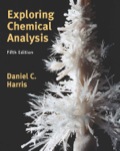
(a)
Interpretation:
Number of plates and plate height and resolution has to be calculated.
Concept Introduction:
Expression to compute number of theoretical plate is as follows:
Here,
It has been found that greater the equilibration steps narrower will be band so this suggests
Expression to compute plate height is as follows:
Here,
(a)
Explanation of Solution
Expression to compute number of theoretical plate is as follows:
Substitute
Thus, number of theoretical plate is
Expression to compute
Substitute
`
Thus, plate height is
Value of
Expression to compute resolution is as follows:
Substitute
Thus, value of resolution is 1.3.
Ratio of plate height is calculated as follows:
Reason behind such massive plate height difference is that rate of longitudinal diffusion is much more rapid in gas than in liquid chromatography.
(a)
Interpretation:
Number of plates and plate height for peak 11 and resolution for peaks 16 and 17 has to be calculated.
Concept Introduction:
Expression to compute number of theoretical plate is as follows:
Here,
It has been found that greater the equilibration steps narrower will be band so this suggests
Expression to compute plate height is as follows:
Here,
(a)
Explanation of Solution
Expression to compute number of theoretical plate is as follows:
Substitute
Thus, number of theoretical plate is
Expression to compute
Substitute
`
Thus, plate height is
Value of
Expression to compute resolution is as follows:
Substitute
Thus, value of resolution is 1.3.
(b)
Interpretation:
Extent of larger plate height has to be calculated and reason behind such massive plate height difference has to be calculated.
Concept Introduction:
Refer to part (a).
(b)
Explanation of Solution
Ratio of plate height is calculated as follows:
Reason behind such massive plate height difference is that rate of longitudinal diffusion is much more rapid in gas than in liquid chromatography.
Want to see more full solutions like this?
Chapter 22 Solutions
EBK EXPLORING CHEMICAL ANALYSIS
- Draw an example of the following functional groups: *see imagearrow_forwardAldehydes and Ketones: Show the reaction conditions, and molecules, that connect the reactant to the product. A protecting group will be needed. *see imagearrow_forwardAldehydes and Ketones: Show the reaction conditions, and molecules, that connect the reactant to the product. *see imagearrow_forward
- Provide the missing information for each of the four reactions: *see imagearrow_forward6. Chlorine dioxide (CIO) is used as a disinfectant in municipal water-treatment plants. It decomposes in a first-order reaction with a rate constant of 14 s. How long would it take for an initial concentration of 0.06 M to decrease to 0.02 M? [6 pts]arrow_forwardIf possible, replace an H atom on the a carbon of the molecule in the drawing area with a methyl group substituent, and replace an H atom on the ẞ carbon with a hydroxyl group substituent. If one of the substituents can't be added for any reason, just don't add it. If neither substituent can be added, check the box under the drawing area. en HO OHarrow_forward
- Curved arrows are used to illustrate the flow of electrons. Use the reaction conditions provided and follow the curved arrows to draw the intermediate and product of this hydrohalogenation reaction. Include all lone pairs and charges as appropriate. Br Select to Draw 51°F Sunny esc F1 HBr Select to Draw 1,2-hydride shift Br Select to Draw Q Search F2 F3 F4 1 2 # # 3 DII L F5 F6 F tA $ % Λarrow_forwardplease help i cant find the article to even startarrow_forwardWhat are the missing reagents for the spots labeled 1 and 3? Please give a detailed explanation and include the drawings and show how the synthesis proceeds with the reagents.arrow_forward
- help with the rf values i am so confusedarrow_forwardPredict the organic reactant of X and Y that are involved in the reaction below, and draw the skeletal ("line") structures of the missing organic reactant. Please include all steps & drawings & explanations.arrow_forwardPredict the major organic product for this reaction.arrow_forward
 ChemistryChemistryISBN:9781305957404Author:Steven S. Zumdahl, Susan A. Zumdahl, Donald J. DeCostePublisher:Cengage Learning
ChemistryChemistryISBN:9781305957404Author:Steven S. Zumdahl, Susan A. Zumdahl, Donald J. DeCostePublisher:Cengage Learning ChemistryChemistryISBN:9781259911156Author:Raymond Chang Dr., Jason Overby ProfessorPublisher:McGraw-Hill Education
ChemistryChemistryISBN:9781259911156Author:Raymond Chang Dr., Jason Overby ProfessorPublisher:McGraw-Hill Education Principles of Instrumental AnalysisChemistryISBN:9781305577213Author:Douglas A. Skoog, F. James Holler, Stanley R. CrouchPublisher:Cengage Learning
Principles of Instrumental AnalysisChemistryISBN:9781305577213Author:Douglas A. Skoog, F. James Holler, Stanley R. CrouchPublisher:Cengage Learning Organic ChemistryChemistryISBN:9780078021558Author:Janice Gorzynski Smith Dr.Publisher:McGraw-Hill Education
Organic ChemistryChemistryISBN:9780078021558Author:Janice Gorzynski Smith Dr.Publisher:McGraw-Hill Education Chemistry: Principles and ReactionsChemistryISBN:9781305079373Author:William L. Masterton, Cecile N. HurleyPublisher:Cengage Learning
Chemistry: Principles and ReactionsChemistryISBN:9781305079373Author:William L. Masterton, Cecile N. HurleyPublisher:Cengage Learning Elementary Principles of Chemical Processes, Bind...ChemistryISBN:9781118431221Author:Richard M. Felder, Ronald W. Rousseau, Lisa G. BullardPublisher:WILEY
Elementary Principles of Chemical Processes, Bind...ChemistryISBN:9781118431221Author:Richard M. Felder, Ronald W. Rousseau, Lisa G. BullardPublisher:WILEY





